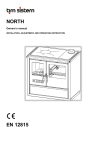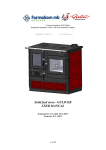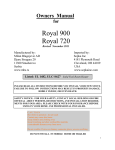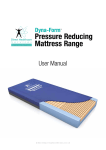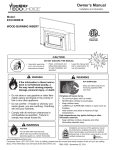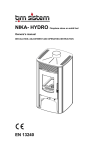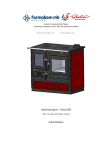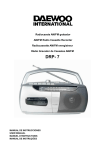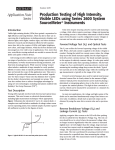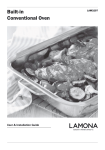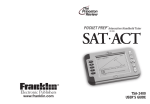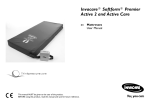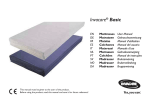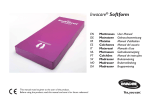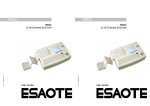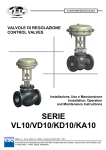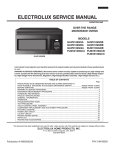Download Manual v2.1
Transcript
NORTH Owners’s manual INSTALATION, ADJUSTMENT AND OPERATING INSTRUCTION EN 12815 Dear Customer, We appreciate your trust wested in us and decision touse "TIM SISTEM" product. You have invested in energy-efficient and high-quality product - NORTH wood burning cooker. Your purchase will provide you long-term clean and comfortable heating with minimal maintenance. Please read these instructions carefully and completely. It’s purpose is to inform you about the installation, operation and maintenance of your stove. Keep it handy and refer to it as needed. You will find in it information that will be useful now and in the years to come. Make sure that when installing the stowe all security standards have been respected and that all gas pipes, connections between tubes and pipes and walls are connected properly. Failure to comply with these standards and carelessness during installation can result in damage to property or put your health and life in danger! Set your cooker to a safe place, away from the frequent passages and doors, somewhere near chimney and chimney connection. We wish you manypleasant moments with NORTH. TIM SISTEM d.o.o. Safety: UL1482 ; ULC-S627 U.S. Environmental Protection Agency This unit is not a certified wood heater. The primary use for this unit is for cooking and baking. Tested by: GUARDIAN Fire Testing Laboratories, Inc [email protected] www.firetesting.com Imported by: Sopka Inc www.sopkainc.com [email protected] Page 2 WARNING BEFORE USE To keep your cooker working properly, it is important to read this manual and strictly stick to the instructions for use and handling. For use with solid fuel only, such as wood and wood briquettes. It is forbidden putting explosive devices and materials combustion chamber or the limited thermal furnace. It is forbidden to keep flammable materials near the stove. For proper combustion, in normal operating mode, draft in the chimney should be 10-12 Pa. If the draft is greater than 15Pa, the valve should be installed in the chimney. Room where the cooker is positioned must be vented regularly for the fresh air needed for combustion. Some parts of cooker heat up during operation and it takes appropriate precaution when handling it. Do not allow children to handle and play near the cooker. Only spare partes reccomended and allowed by the manufacturershould be installed on the cooker. You must not make any changes on the cooker. With first firing there might show a mild smoke, especially from the plate’s surface. It is a common appearance that occurs due to combustion deposits on the plate’s surface (corrosion protection, paint, dust ...). The room where the cooker is should be vented during the first firing. It’s not reccomended connecting the cooker to the common chimney because it can adversely affect the required draft. Device that uses gas as fuel must notbe connected to same chimney. During firing, use protection gloves because the door handles get heated. National and local regulations for the installation of the furnace must be respected. In a case of non-copliance with instructions given in this manual, manufacturer does not take any kind of responsability for caused damage. Page 3 DESCRIPTION OF THE COOKER North Wood burning cooker is intended to be used for cooking and baking food and it's manufactured and tested according European EN 12815 and UL1482, ULC-S627, American and Canadian standards. The upper plate of the fireplace is made of steal. Firebox doors are made of steal with fireproof glass. Connection for smoke drainis being put on the plate and connected with screws. All the materials that NORTH cooker is made can be recycled. Sealing elements are made of materials that NOT contain asbestos. Parts of the COOKER: 1. 2. 3. 4. 5. 6. 7. 8. Protection rail Hotplate Smoke exhaust Flue gases register Thermometer Oven Oven door Oven door handle 9. Wood drawer 10. Firebox door handle 11. Primary air regulator 12. Firebox door 13. Firebox 14. Secondary air regulator Page 4 TECHNICAL DATA Name NORTH Use Nominal power efficiency Solid fuel cooker Btu 31,500 % 84 Fuel Wood, wood briquets Dimensions of the cooker W x L x H in 35.5x23.7x33.5 Dimensions of the fire place W x L x H in 11.5x17.7x11 Dimensions of the oven W x L x H in 13.8x18.7x11.6 Weight lbs 265 Back in 6 Side in 6 Front in 36 Content CO (reduced on 13% O2) [%] % 0,091 Chimney connection in 6 Minimum distance from flammable materials Chimney connection position Consuption by nominal power Emission temperature Left/right upper plate kg/h 1,5 °C 239 Air regulation Primary Secondary Required draft Pa/wc 12±2/ 0.040 – 0.057 Page 5 INSTALLING THE COOKER Cooker must not be set up near the wooden parts, refrigeration parts, plastic furniture and other flammable materials because during operation (during fuel combustion) it achieves high operating temperature that is distributed on the outside of the furnace. Minimum distance between the stove and the surrounding elements is 6”. If the ground on which you set the cooker is made of easily flammable material (wood, warm floor, laminate ...) you need to set under the cooker a protetion sheet metal or any non flammable floor protector. Because of its weight, the cooker must be installed on the appropriate base. If it does not satisfie necessary standard, you must take appropriate measures to make it possible (eg, weight distribution). Connect the cooker to a chimney and flue pipes through the connector on top of the furnace, so as to ensure adequate tightness and flow of smoke from the stove to the chimney. Flue pipe must not be drawn too deeply into the chimney that would reduce the cross sectional area and thus undermined draft in the chimney. Do not use reducers which reduce the cross section of pipe smoke. The cooker requires insertion of fresh air in the room where it is installed, with surface openings for insertion of fresh air should not be less than 0.4 dm ². The unit for fresh air set outside the common room for ventilation, which must be insured by door and gride. Fans that work in the same room where the cooker is installed may make interference wit the the cooker. Also, all devices or ventilation that creates negative pressure in the room where the cooker is installed, must be set in the way that does not make decompression that prevents normal operation of the furnace. Before installing the cooker, check the chimney drafts because it is a key factor in the proper functioning of the cooker. Draft depends on the proper opration of the chimney and meteorological conditions. One of the easiest ways to check the draft in the chimney is with a candle flame, as shown in Figure 2 . Put a candle near the chimney connection drain. If the flame bends towards drain, the draft is satisfying (Figure 2b). If the flame doesn’t bend or bends a little, that indicates poor draft (Figure 2a). If there is poor draft in the chimney (Figure 2a), check the chimney operation. The chimney should be located inside the building, and if it’s located on the external walls of the building, it’s recommended insulation chimney. Figure 2a. Figure 2b. Page 6 Disadvantages of the chimney (Figure 3): ` 1. The chimney is higher than the top of the roof, a small cross section of the output, 2. Excessive slope 3. A sudden change of direction of the flue channel 4. Stove or some other device connected to the same flue channel, 5. Bulges in the flue channel 6. Cracks 7. Alien body or accumulated grime, 8. Tube inserted too deeply, 9. Fan or other device that creates a vacuum in the room 10. Unsealed or opened cleaning hole Figure 3. Page 7 IGNITION AND LIGHTING Before the first firing, wipe all painted surfaces withclean and dry cloth, in order to avoid burning impurity on the oven and creation of unpleasant smells. Start the fire in the stoveby following order: • open the fire door, • place the fluel into the fire place (chopped wood to non greasy wrinkled paper) • light a fire • leave open primary air regulator until the flame gets stable and after having stabilized the flame,control burning intensity with draftsregulator (Fig. 1, pos. 11) • secondary air regulator leave opened until the flame gets stable and after having stabilized the flame, control burning intensity with regulator (Fig. 1, poz.14) • close the firebox door, • after creating a basic flame insert larger pieces of wood or briquettesin the firebox, and close the firebox door. If you use briquettes as a fuel, you must wait that all biquettes are then reduce the draft in half. lit and • when adding fuel, (Fig. 1, pos. 12) open the fire door step by step wait for 4-5 seconds, and then slowly open it wide. Do not open the doorsuddenly, when there’s a strong flame in the combustion chamber, it may come to it’s spreaading into the room. Regulating the draft in the cooker, you can regulate temperature, power and the combustion of fuel, and this is done by running draft regulator on the firebox door (Fig. 1, pos. 11). Combining primary air through the regulator onthe firebox door and secondary air over the leverage above the firebox door (Fig. 1, pos. 14) you get desired combustion. Cooker contains auxiliary tools in order to facilitate its maintenance. Recommended fuel: cord wood max length 16". You must not use gasoline and similar fuels, because by using liquid fuels you crate conditions for damaging the stove and to provoce an explosion. Page 8 Attention! • Do not use organic wasteas fuel, food residue, plastic, combustible or explosive materials, which combustion disturbs the proper functioning of the cooker and may cause damage and environmental pollution. • Increased ambient temperature can cause poor air circulation (drafts) in the chimney, and in that case is recommended more frequent firing in smaller quantities. • Avoid using the cooker when there are bad weather conditions for the cooker andin the case of strong wind, because it reflects the required vacuum in the chimney. In these cases there may occure potential return of smoke in the room where the cooker is placed. Ignition is difficult then. We recommend firing every hour with the amount of fuel in the combustion chamber up to 15cm with cross stacking wood for better airflow. After each refilling, it’s reccomender to leave the oven running in full speed for 30 minutes,in order to destroy all volatile elements that may cause condesation in the cooker. Correct cooker operation demands: - Regular cleaning of the cooker and chimney Regular room ventilation for better combustion Regular ash tray cleaning Accumulated slag and unburned material regularly remove from the grid WORKING REGIMES There are four working regimes, which could be selected by adjusting the draught in the cooker. Combined working regime - working regime in which it could be cooked in the oven, cooked on the top of the hotplate and heat the room at the same time. It is necessary to push the flue gas register handle towards the inside of the cooker, move primary air regulator to create medium inlet of the air. Quick cooking - during this process it is the hotplate heats up intensively and to be able to do that with small quantity of fuel, draw flue gas register handle completely outside, oven door should be shut and move primary air regulator to create medium inlet of the air. Heating for this regime it would be recommended to use wood or coal. If the coal is been used it would require more frequent firing in order to create the ember which would intensively heat the hotplate of the cooker. Push the flue gas register handle towards the inside of the cooker, move primary air regulator to create medium inlet of the air and the oven’s door closed. Baking for this regime push the flue gas register handle towards the inside of the cooker, move primary air regulator to create medium inlet of the air and the oven’s door closed after putting the baking pan inside. Page 9 HANDLING THE COOKER OPERATION Start a fire with a moderate flame in order to avoid thermal shocks. The following amounts of wood are inserted only after the previous volume burn. Do not allow that ashes and unburned accumulate on the grid and to ta pit that way. Clean the grid. Open the door slowly and carefully, allowing that way equalization of pressure in the firebox and in the room, otherwise itmight cause the smoke in the room. The cooker is designed and intended for use with firebox door constantly closed, except during refueling. Do not open the door with no need. The wood must be a maximum of 19% moisture content for maximum fire effect. Otherwise the tar gets separated which with water steam may crate creosite. If that happens in some bigger quantitiy, it may lead to a chimney fire. You will most easily recognize chimney fire by: the characteristic sound that comes out of the chimney like loud roaring, visible flames coming out of the chimney, high ambient temperatures of surrounding walls and the characteristic smell of burning. If there comes to the fire do the following: • Immediately call the fire squad • muffle oxygen supply to the chimney and turn off the cooker • Do not insert anything into the chimney and make sure that the fire does not spread to the wooden construction or other combustible materials in its nearby. • DO NOT pour water into the cooker or chimney • A fire in the chimney can be extinct only with dry powder • Water can extinguish only a surrounding material • Do not cool the surrounding walls with water Note: If the fire in the cooker for some reason becomes dangerously strong take the following measures: close air dampers that provide air for combustion. If it is necessary put in the firebox specially prepared sand for this purpose or non-combustible fire blanket. It would be good to have a fire extinguisher. Before the second charging, clean the gridin order to provide the fresh air. Regularly clean the ash pan making sure that there is always a place for ashes. The furnace is designed to operate in periodic mode. To maintain the required nominal power, combustion chamber is periodically filled with prestabled amount of fuel. Furnace is not designed to operate in continuous modeof heating or in accumulating temperature mode. Page 10 CLEANING AND MAINTENANCE Regular and proper cleaning allows proper operation and long life of the stove. All cleaning the interior or exterior surfaces are always performed in a cold oven. Cleaning exterior surfaces - is done with a soft cloth that will not damage the surface of the stove. Cleaners of chemical origin can damage the surface of the fire place and cannot be used. Painted surfaces must not be cleaned with abrasive products. Cleaning inter surfaces –when cleaning use protective gloves. Clean the bottom of the ovenfrom accumulated ash and pick up small unburned pieces of the grid, clean the ashtray and ash accumulated in the interior of the fireplace. Cleaning glass surfaces - glass on the firebox may get dirthy during the operation. For cleaning use a mild detergent. Do not use abrasive cleaners because they can damage the surface of the glass. Clean the glass only when cool. Cleaning and maintenance of the chimney - chimney cleaning and control is recommended at least once a year and after a long downtime. Regular maintenance and control of the chimney will prevent the occurrence of fire and poor operation of stow. Malfunction. Recommendations for its elimination The following table shows the most common defects and recommendations for their removal. Table: Showing the most common malfunctions, possible causes and ways of eliminating it. Malfunction Oven heats poorly Possible cause improper handling, Poor uptake Howe to remove it Read carefully and follow the instructions. Inthe case that despite all instructionshave been respected, malfunctions are still not removed, call the customer service Closed regulator of air supply, Wet wood, Lack of oxygene Open the regulator of air supplyand provide a supply of a primary air Use a dry wood Ventilate a room in order to provide a supply of fresh air Smoke reenters into a room Closed regulator of air supply, Insufficient draft, Remainings of ashes on a grid Open the regulator of air supplyand provide a supply of a primary air Read carefully the instructions and apply advices how to provide a draft Clean the grid Glass on a firebox door are getting sooty for a while Wet wood Too much fuel Insufficient draft Use a dry wood Check a suggested quantity of a fuel provided in a user’s manual Difficulties in lighting fire Page 11 Closed intake of secundary air Check a connection with a chimney Read carefully the instructions and apply advices how to provide secundary air GENERAL RECOMMANDATION If you have fullfield all the recommendations for installation, operation and control of cleaning, giveen in this manual, the stove is now tested, safe device for household use. Before installing the stove, remove the package. Be aware of potential injuries because the wooden slats are connected with nails. Dispose a plastic bag in accordance with the regulations. Old stove you do not want to use anymore, dispose to designated areas in accordance with the regulations. All complaints, perceived failure or malfunctioning stoves, should be reported to the factory or authorized service center by telephone or in written, only with fiscal receipt. All contact information provided at the end of this guide. Any malfunction of the cooker, must be removed by the manufacturer’s service only. If unauthorized persons carry out any servicing or repairs and alterations to the stove, the owner loses the right to the manufacturer's warranty. Supply of spare parts has to be done viamanufacturer’sservice, based on the position and image of this manual. The manufacturer does not assume any responsibility if the buyer fails to comply with the instructions for use and installation of the stove. ADVICES FOR ENVIRONMENT PROTECTION PACKAGING Packaging material is 100% recyclable. For a waste disposal of, act in accordance with local regulations. Packaging material (plastic bags, polystyrene parts-polystyrene, etc.), should be kept away from children, as a potential source of danger. Take care of safe removing and disposing of wooden boards because they are connected with nails. PRODUCT The device is made of materials that can be recycled. When disposing the waste,act in accordance with enviromental laws in effect. Use only the recommended fuel. It is forbiden burning an inorganic and organic materials (plastics, plywood,textile, oiled wood, etc..), because the combustion releases carcinogenic materials and other toxics. Page 12 SOLID FUEL COOKER “NORTH” Page 13 List of all Positions on the "NORTH" cooker 1. Smoke exhaust 2. Hotplate carrier 3. Cookers frame 4. Flue gas register handle 5. Oven protector 6. Flue gas register 7. Rear inner panel 8. Rear exterior panel 9. Partition firebox panel 10. Rear carrier side panel 11. Inner side plate 12. Carrier side brick 13. Assembly oven 14. Deflector below the oven 15. Front carrier side panel 16. Oven grill 17. Side panel 18. Bottom of the oven 19. Corps carrier 20. Bottom plate 21. Mount drawer slide 22. Base assembly 23. Stationary slider 24. Moving slider 25. Decorative drawers mask 26. Wood drawer assembly 27. Wood drawer handle 28. Oven door 29. Oven door glass 30. Thermometer 31. Doors handle 32. Primary air regulator 33. Firebox door 34. Primary air box 35. Firebox door glass 36. Secondary air regulator 37. Decorative plate 38. Grill 39. Front plate assembly 40. Front plate protector 41. Side brick 42. Secondary air box 43. Side panel protector 44. Protection rail carrier 45. Protection rail 46. Hotplate 47. Back brick 48. Uper brick Page 14 DIMENSIONS OF THE COOKER Page 15 Owner’s Manual Tested to UL 1482, ULC-S627 Solid Fuel Cook Stove d to to:: EN 1281 5 Teste ted 815 PLEASE READ ALL INSTRUCTIONS BEFORE YOU INSTALL YOUR NEW STOVE. FAILURE TO FOLLOW INSTRUCTIONS MAY RESULT IN PROPERTY DAMAGE, BODILY INJURY, OR EVEN DEATH. SAFETY NOTICE: FOR YOUR SAFETY, CONTACT LOCAL BUILDING OR FIRE OFFICIAL ABOUT PERMITS, RESTRICTIONS, AND INSTALLATION REQUIRE-MENTS FOR YOUR AREA. PLEASE CHECK WITH YOUR INSURANCE BEFORE USING IN YOUR HOME. USE PROFESSIONAL INSTALLER. CAUTION Hot while in operation- do not touch Contact may cause skin burns Keep children and clothing away Keep furnishing and other combustible materials a considerable distance away from stove. Do not overfire. If stove or chimney connector glows, you are overfiring DO NOT INSTALL IN MOBILE HOME OR TRAILER Page 16 SAFETY INSTRUCTIONS Read all instructions carefully. 1. The installation of this stove must comply with your local building codes. Please observe the clearance to combustible. Stove must be 6"(15 cm) from any combustible material, wall, wood, furniture, paper, etc. 2. Always connect this stove to a chimney and vent outside. This stove requires approved masonry or factory build 6" diameter UL 103 Type HT chimney, that is high enough to give good draft. 3. Do NOT connect this stove to a chimney flue serving another appliance. 4. Be sure that your chimney is safely constructed and in good repair. Have chimney inspected by the fire department or a qualified inspector. 5. Creosote or soot may build up in the chimney connector and chimney and may cause a house or building fire. Inspect the chimney connector and chimney twice monthly during the heating season and clean if necessary. 6. Burning any kind of fuel uses oxygen from the dwelling. Provide fresh air for proper combustion from outside the house into the room where the stove is located. 7. To prevent injury, do NOT allow anyone to use this stove who is unfamiliar with the correct operation of the stove. Do not operate stove while under the influence of drugs or alcohol. 8. Flue connector pipe should be 6" diameter, minimum single wall 24 msg black or 25 msg blued steel. (Listed to UL 103, Type HT and evaluated to CAN/ULC-S629-M87) 9. Do Not overfire. The special paint used on stove may give off some smoke and an odor while they are curing during first few fires. Open windows and doors as needed to clear smoke and odor. Overfiring may cause some damage to the stove. 10. Use only dry, seasoned, natural untreated wood. Do not burn garbage or flammable fluids, such as gasoline, naphtha, kerosene or engine oil. 11. Use the metal ash drawer only to dispose of ashes. Dispose of ashes in a metal container with a tight fitting lid. Keep the closed container on a non-combustible floor, well away from all combustible materials. Keep ashes in the closed container until all cinders have thoroughly cooled. The ashes may be buried in the ground or picked up by a refuse collec-tor. 12. CAUTION: Hot while in operation. All person, especially young children should be alerted and trained to stay a safe distance from the stove. Small children should be all the time care-fully supervised when they are in the same room with the stove. 13. This stove requires non-combustible floor protection. 14. Keep stove area clear and free from all combustible materials such as gasoline and/or other flammable vapors and liquids at minimum 40". 15. Never leave an unattended woodstove burning on high. 16. It is highly recommended to install smoke and carbon monoxide detectors in the home when installing a wood stove. SAVE THESE INSTRUCTIONS Page 17 INSTALLATION INSTRUCTION NOTE: FLOOR EMBER PROTECTION IS REQUIRED FOR SPARK AND ASH SHIELDING, NOT FOR LIMITING FLOOR TEMPERATURE FROM THE RADIANT HEAT OF THE APPLIANCE. 1. Proper clearances must be maintained for adequate air circulation. Adequate ventilation must be provided while operating this stove. 2. The stove must be placed on solid masonry, solid concrete, or when installing on combustible floor, on a UL 1618 listed floor protector or flammable floor must be protected by in-sulating plate ( steel, brass, marble, stone, ceramic tiles, etc.) . The base must extend at least 18" (46 cm) beyond the front of the stove and 8"(20 cm) to the sides, and MUST extend under the stove pipe. (Check local building codes and fire protection ordinances.) Floor protector minimum size; 52“ x 50“ (131cm x 126cm) 3. The stove must have its own flue. DO NOT CONNECT THIS UNIT TO A CHIMNEY SERVING OTHER APPLIANCES. 4. Connect flue collar to the stove and adapter for creosote leakage. The crimped end of the stove pipe must be installed facing down to fit inside the adapter. Figure 1, page 11 5. Use three (3) sheet metal screws at each joint of stove pipe and adapter to firmly hold stove pipe together. Use 6" round black/blue stove pipe (Listed to UL 103, Type HT and evaluat-ed to CAN/ULC-S629-M87) NOT galvanized pipe. DO NOT CONNECT THIS STOVE TO ANY AIR DISTRIBUTUIN OR DUCT SYSTEM. 6. Slope any horizontal single wall pipe and ceiling stove pipe upward toward the chimney at least 1/4 inch for each foot of horizontal run. 7. You must have at least 18" of clearance between any horizontal pipe and ceiling. 8. The stove pipe must NOT extend to far into the chimney flue. 9. It is recommended that no more than two (2) 90 degree bends be used in the stove pipe installation. 10. Connect to 6" inspected masonry chimney or 6" UL Type HT listed chimney. MASONRY CHIMNEY Before using an existing masonry chimney, clean the chimney, inspect the flue liner and make any repair needed to be sure it is safe to use. If connector stove pipe must go through a combustible wall before entering the masonry chim-ney, consult a qualified mason or chimney dealer. The installation must conform to local fire codes, and NFPA 211. Do NOT connect this stove into the same chimney flue as the fireplace or flue from another stove. If there is a cleanout opening in the base of the chimney, close it tightly. UL LISTED CHIMNEY Carefully follow chimney manufacturer's instructions. Us only a UL 103 Type HT Listed Resi-dential Type and Building Heating Appliance Chimney. The top of the chimney must be at least three (3) feet above the roof and be at least two (2) feet higher than any point of the roof within ten (10) feet. A PROFESSIONAL, LICENSED HEATHING AND COOLING CONTRACTOR SHOULD BE CONSULTED IF YOU HAVE QUESTIONS REGARDING THE INSTALLATION OF THIS SOLID FUEL BURNING APPLIANCE. Page 18 Chimney connector systems and clearances Chimney connector shall not pass through attic or roof space, closet or similar concealed space, or a floor, or ceiling. When passage through a wall, or partition of combustible is desired, the installation shall con-form to CAN/CSA-B365, Installation Code for Solid-Fuel-Burning Appliances and Equipment: Page 19 CLEARANCES: Back of Stove Side of Stove Combustible 12" (30cm) 12" (30cm) NON-combustible (Protected Walls) 4" (10cm) 4" (10cm) Page 20 Page 21 MINIMUM CLEARANCES TO COMBUSTIBLE SURFACES Unit to Sidewall - - - - - - - - - - - -12" (30 Unit to Backwall - - - - - - - - - - - -12" (30 Unit Corner to wall - - - - - - - - - 12" (30 Pipe Connector to Ceiling - - - - - - - 18" (46 cm) CAUTION: KEEP FURNISHING AND OTHER cm) COMBUSTIBLE MATERIALS AWAY FROM THE STOVE. cm) cm) Clearances may only be reduced by means approved by regulatory authority. OPERATION OF THE STOVE 1. Burn wood only. The wood should be natural, air dried (seasoned) for at least six (6) months. Before lighting open draft, located on front left or right side of stove. Light wood using paper, twigs, etc. NEVER USE ANY FLAMMABLE LIQUIDS OR GASOLINE TO START OR FRESHEN UP A FIRE IN THE STOVE. 2. After the fire has been started, adjust the rate of burning by opening or closing the draft con-trol. 3. Do NOT touch the stove after firing until is has cooled. 4. Never overfire this stove by building excessively hot fires. 5. If stove begins to glow or turn red, you are overfiring the stove. 6. Inspect stovepipe every 60 days. Replace immediately if stove pipe is rusting or leaking smoke. 7. Inspect the stove pipes, connectors, and chimney twice monthly during the heating season and clean if necessary. CAUTION: SLOW BURNING FIRES AND EXTENDED USE MAY CAUSE EXCES-SIVE CREOSOTE BUILDUP. IGNITION OF CREOSOTE/SOOT OR OVERFIRING MAY CAUSE CHIMNEY FIRE. CHIMNEY FIRES BURN EXTREMELY HOT AND MAY IGNITE SURROUNDING MATERIALS. IN CASE OF CHIMNEY FIRE CALL THE FIRE DEPARTMENT IMMEDIATELY. CHIMNEY MAINTENANCE - Creosote/Soot Formation and Need for Removal When wood is burned slowly, it produces tar and other organic vapors which combine with ex-pelled moisture to form creosote. The creosote vapors condense in relatively cool chimney flue of a slow burning fire. As a result, creosote residue accumulates on the flue lining. When ignit-ed, this soot/creosote makes an extremely hot fire. The chimney and the chimney connector should be inspected at least twice monthly. If creosote/soot has accumulated, it should be removed. Failure to remove creosote/soot may cause a house or building fire. Creosote/soot may be removed by using chimney brush. Chimney fires burn very hot. If the chimney connector glows red, immediately call the fire department. PROVIDE AIR INTO THE ROOM FOR PROPER COMBUSTION. Page 22 CAUTION: HOT WHILE IN OPERATION. KEEP CHILDREN, ANIMALS, CLOTH-ING AND FURNITURE AWAY FROM THE STOVE. DO NOT TOUCH HOT STOVE. CONTACT MAY CAUSE SKIN BURNS. TRAIN CHILDREN TO STAY A SAFE DIS-TANCE FROM THE UNIT. CHILDREN SHOULD BE ALL THE TIME CAREFULLY SUPERVISED WHEN THEY ARE IN THE SAME ROOM WITH THE STOVE. CAUTION: NEVER USE CHEMICALS, GASOLINE, KEROSENE, CHARCOAL LIGHTER FLUID OR SIMILAR FLAMMABLE LIQUIDS TO START OR FRESHEN UP A FIRE IN THE STOVE. KEEP ALL FLAMMEBLE LIQUIDS AWAY FROM THE STOVE-WHETER IN USE OR IN STORAGE. OPERATING SAFETY PRECAUTIONS 1. NEVER BUILD EXTREMELY LARGE FIRES IN THE STOVE AS DAMAGE TO THE STOVE OR SMOKE LEAKAGE MAY RESULT. 2. NEVER OVERFIRE THIS STOVE BY BUILDING EXCESSIVELY HOT FIRES AS A HOUSE OR BULDING FIRE MAY RESULT. YOU ARE OVERFIRING THE STOVE IF STOVE OR STOVE PIPE BEGINS TO GLOW OR TURN RED. 3. PROVIDE AIR INTO THE ROOM FOR PROPER COMBUSTION. 4. USE SOLID NATURAL AIR DRIED (SEASONED) WOOD and COAL, only. 5. INSPECT STOVE PIPES, CHIMNEY AND STOVE AT LEAST TWICE A MONTH AND CLEAN IF NECESSARY. 6. WHILE IN OPERATION, KEEP THE FEED DOOR CLOSED ALL THE TIME, EXCEPT WHILE TENDING THE FIRE. ALWAYS OPEN DRAFT CONTROLER BEFORE OPENING THE FEED DOOR. ABOUT DRAFT: The principle of draft is that warm air rises. Your chimney provides draft which sucks the smoke up the chimney. The stove does NOT PUSH out the smoke. Your stove has been design and approved for use under normal conditions. Unacceptable smoking usually indicates poor draft in your chimney. Normal operating draft for this stove is 12 Pa +- 2 Pa( 0.04 w.c. - 0.055 w.c.). For draft above 15 Pa ( 0.06 w.c.) install a stovepipe damper. Gauges to measure draft are readily available at stove stores and are economical to rent or purchase. Should you have a problem with inadequate draft, you should contact a licensed heating and cooling contractor for assistance in solving the problem. PROBABLE CAUSES FOR SMOKING ARE: Insufficient chimney height above nearby obstructions. Clogged or obstructed chimney system Downdraft caused by nearby trees, hills, buildings, etc. Negative draft. In a cold chimney, a cold air column rushing down the chimney can prevent stove start-up causing the stove or chimney pipe joins to smoke. SOLUTION: Open nearby window, and use small strips of newspaper or tinder loosely placed in the firebox that will pro-vide quick and hot heat up the chimney, thereby reversing draft. Page 23 SINGLE WALL PIPE-MINIMUM CLEARANCES FOR USA/CANADA Some example of clearance reduction; • Using heat shields on back and sidewalls allowing at least 1" of space away from the walls for ventilation. The inch spacing is necessary to ensure air circulation between the protection and the wall so that the wall is not subject to high temperatures. The spacer used must be non-combustible. Another method to achieve the same type of protection is using brick or masonry with 1" air space between the brick or masonry and the wall. When reducing distances, please check local codes and consult with professional installer. • Using special interior double wall stove pipe can reduce distance. • Protecting wall or ceiling adjacent to the pipe. • Installing an approve 'pipe heat shield' onto the stove pipe. • WARNING: Do not place stove to close to the shield. There should be enough space between for proper air ventilation. Page 24 RULES FOR INSTALLATION The stove may not be positioned in the immediate vicinity of the wooden elements, parts made of plastic, textile and other flammable materials because during the operation (during the fuel combustion) it has high work temperature which is distributed on the outside of the stove. The smallest distance between the stove and surrounding elements should be 6'(15cm) (sideways and from the back side). Safe distance from the front side is 6'(15cm). The stove may not be positioned in the immediate vicinity of the cooling equipment (refrigerators, freezers etc.). In case that the load bearing capacity of the floor does not suit the stove weight, take cautionary measures to increase its load bearing capacity. Moreover, if there is a flammable floor, a non flammable plate must be positioned between the floor and the stove and it must extend at least 46 cm(18”) from the front and at least 20 cm(8”) from the sides. The stove is connected to the chimney with appropriate smoke pipes in order to provide an adequate tightness and flow of smoke from the stove to the chimney. The smoke pipe must not be too deeply positioned in the chimney in order not to reduce the surface of the cross cut and disturb the draft in the chimney. CHIMNEY Special attention should be drawn to the chimney quality which has to be manufactured according to standards. The maintenance of the chimney has to be regular. The stove is connected to the chimney through the fitting via appropriate smoke pipes, in order to provide the adequate tightness and the flow of smoke from the stove to the chimney. The smoke pipe must not be positioned too deep in the chimney in order not to disturb the draft in the chimney. AIRFLOW To ensure adequate stove operation, the draft in the stove chimney flue should be 12±2 Pa. The lower value does not allow the proper combustion, and as the consequence there is the deposit of carbon and excess quantity of smoke which goes out through the grilles or the door. If the value of the airflow is too high, the combustion shall be too fast, and as the result the heat goes out through the chimney. In case of draft greater than 15 Pa, the chimney flue must be fitted with a damper. The signs of bad airflow are: ·Dirty glass, hot handle ·Smoke enters the room Glass Care Caution: Never operate the stove with a broken door glass. Never build the fire up against the glass. Warning: Do not use any replacement glass other than the original “ceramic” glass manufactured and supplied for use in this cookstove. Replacement glass is available from manufacturer or authorized dealer. Do not abuse glass door by striking or slamming it. Never clean hot glass. Never use abrasive cleaner. When necessary, the glass can be cleaned with low alkaline content commercial stove glass cleaners, which are available from your local dealer Page 25 The chimney guarantees the conveyance of the fumes outwards even when there are strong horizontal winds and stops them from being blown back down the chimney. Bad maintenance of the chimney stops the smoke passage due to breakage or separation of cement mortar, brick or other material used for chimney construction, as well as due to product deposits combustion and intrusion of foreign objects. Chimney must have sufficient heat insulation; otherwise it can lead to condensation. The internal parts of the whole flue should have a smooth surface, and the material used should be chemically and thermally resistant to products of combustion. In case of any problems connected with chimney, you should consult professionals and chimney sweepers. LIGHTING Prior to the first stove lighting, it is necessary to wipe all stove surfaces with a dry cloth, remove dust, oil and impurities from the stove plate and the oven in order to avoid their combustion and uccurence of unpleasant odours and smoke. The first time that the appliance is lit, there will be an unpleasant odour and smoke given off, especially from the stove plate surface, as well as from the other parts protected with a heat resistant paint. This is a normal occurrence because the paint stabilizes on temperatures above 250°C during the first lighting. A good ventilation of the room where the stove is located must be ensured. Important: The stove has been made from materials which are NOT harmful for health. Page 26 GENERAL NOTES If all recommendations for installation, regulation of operation and cleaning have been respected, the stove represents a safe domestic appliance. In case of any problems, please contact the producer or distributor by telephone or in written form. Contact data are given at the end of this instruction. Any defect on the stove shall be removed by the authorized service. If an unauthorized person performs service or any changes on the stove, the owner of the stove loses the right for the service provided by the manufacturer’s warranty. The supply of spare parts is performed exclusively through the factory service, based on the positions and pictures in this instruction and their names. The manufacturer is not liable if the buyer does not respect the installation and operation manual. The manufacturer reserves the right to make modifications in appearance, dimensions and the model without the previous notice. Limited One year Warranty "Tim Sistem" warrants its products against manufacturing defects to the original purchaser only—i.e., individual (register customer) wh ose name appear on the warranty registration card., for a period of One year from date of purchase from only an authorized dealer. If within the one year period, your product should develop a defect due to materials or workmanship of the original new product,Tim Sistem (manufacturer), Sopka Inc (importer), or your authorized dealer will supply ONLY the parts necessary to make the repairs. (Labor Not Included) and is subject to following condition and limitations: This limited warranty does not cover damages caused by misuse, lack of maintenance, accident, alterations, abuse or neglect. This limited warranty does not cover any scratches, dents, corrosion or discoloring caused by excessive heat, cleaning chemicals, nor chipping on porcelain enamel parts, nor any venting components used in the installation. Installation must be done in accordance with installation instructions included with product and all local and national building and fire codes. Tim Sistem or Sopka Inc will not be liable for incidental and consequential damage of any nature. This warranty gives the purchaser specific legal rights which may vary from state to state. No other warranty is to be implied or expressed, including warranties implied for a specific or particular purpose. Tim Sistem reserves the right to have its representative inspect any product or part thereof prior to honoring any warranty claim. Page 27 Imported and Distributed by: Sopka Inc., USA 216-543-7002 www.sopkainc.com [email protected] Tim Sistem Prva industrijska 9 22330 Nova Pazova, Serbia www.timsistem.rs Made in Serbia Listed and Labeled by: Tested to: UL 1482, ULC-S627 Tested to: EN 12815: 2001 Guardian Fire Testing Laboratory www.firetesting.com - Solid Fuel Cook Stove - For Use with Solid Wood Fuel only Model Modèle □ North Date of manufacture Date of fabrication Month Mois TO PREVENT HOUSE FIRES: Contact local building or fire officials about restrictions and installation inspection in your area. Install and use only in accordance with manufacturers's installaton and operating instructions and local codes. In the absence of any local codes, installation must meet minimum requirements of NFPA 211 in the USA, and B365 in Canada. Refer to manufacturer’s instructions and local codes for precautions required for passing a chimney through a combustible wall or ceiling. Inspect and clean chimney system frequently in accordance with manufacturer’s instruction. Do not connect this stove to a chimney flue serving another appliance. Do not use grate or elevate fire. Build wood fire directly on hearth. Flue connector pipe must be 6” diameter, minimum single wall 24 msg black or 25 msg blued steel. Chimney must be factory built 6” diameter Class,"A" 103 Type HT, or masonry. TO PREVENT CREOSOTE FIRES: Inspect and clean chimney frequently - under certain conditions of use, creosote buildup may occur rapidly. Do not use other fuels than firewood. CAUTION: Fully open combustion air control before opening the fuel feed door. Only operate the wood heater with the doors closed. Replace fire box glass only with original "Ceramic" glass available from manufacturer or authorized dealer, only. Parallel & Corner Year Année Serial No. No de série POUR EVITER LES INCENDIES DOMESTIQUES: Contactez les Autorités des bâtiments et les pompiers pour obtenir des instructions concernant les restrictions et inspections d'installation dans votre région. Installez et utillisez cet appareil uniquement en respectant les instructions d'installation et d'utilisation du fabriquant. Respectez également les réglementations locales. En l' absence de réglementations locales, l' installation doit respecter les normes minimales de NFPA 211 aux Etats -Unis et B365 au Canada. Référez-vous aux instructions du fabriquant aux réglementations locales pour obtenir des instructions concernant les précautions nécessaires pour le passage de la cheminée á travers une paroi ou un plafond combustible. Inspectez et nettoyez le systeme de cheminée fréquement selon les instructions du fabriquant. Ne connectez pas ce poele a un conduit de cheminée utilisé par un autre appareil. N'utilisez pas de grille et ne faites pas monter le feu. Etablissez le feu de bois directement dans l'âtre. Le tuyau de connexion au conduit doit avoir un diametre de 6" (152 mm), une paroi unique en acier de 24 msg (noir) ou 25 msg (bleu). Le matériau de la cheminée doit etre 103HT de classe A de 6" (152 mm) ou une construction en dur. POUR EVITER LES FEUX DE CREOSOTE: Inspectez et nettoyez la cheminée régulierement - Sous certaines condition d'emploi, la créosote peut s'accumuler rapidement. Ne pas utiliser d'autres combustibles que le bois. ATTENTION: Ouvrez complétement le contrôle d' air de combustion avant d' ouvrir la porte du foyer. N'utilisez le poele que lorsque les portes sont fermées. Remplacez la vitre du foyer de feu seulement par une vitre en "céramique" d'origine, fournieuniquement, par le fabricant ou un revendeur autorisé. A B C D E F Single Wall Connector 6" (15cm) 18" (46cm) 6" (15cm) 18" (46cm) 6" (15cm) 84" (213cm) Double Wall Connector 6" (15cm) 6" (15cm) 6" (15cm) 6" (15cm) 6" (15cm) 84" (213cm) Floor / Ember protector minimum size: 52" x 50" (131cm x 126cm). Clearances can be reduced with shielding acceptable to local authorities. Reduced installation must comply with NFPA 211 or CAN/CSA-B365. CAUTION HOT WHILE IN OPERATION - DO NOT TOUCH. KEEP CHILDREN AND CLOTHING AWAY. CONTACT MAY CAUSE SKIN BURNS. SEE NAMEPLATE AND INSTRUCTIONS. KEEP FURNISHINGS AND OTHER COMBUSTIBLE MATERIALS A CONSIDERABLE DISTANCE AWAY FROM THE APPLIANCE. DO NOT OVERFIRE - IF HEATER OR CHIMNEY CONNECTOR GLOWS, YOU ARE OVERFIRING. ATTENTION CHAUD PENDANT LE FONCTIONNEMENT - NE PAS TOUCHER. TENIR ELOIGNES LES ENFANTS ET LES VETEMENTS - LE CONTACT PEU CAUSER DES BRULURES. CONSULTEZ LA PLAQUE D'IMMATRICULATION ET LES INSTRUCTIONS. TENIR LES FOURNITURES ET AUTRES MATIERES COMBUSTIBLES A DISTANCE DE L'APPAREIL. EVITER DE SURCHAUFFER - SI LE FEU OU LA CHEMINE DEVIENT ROUGE, VOUS SURCHAUFFEZ. DO NOT REMOVE THIS LABEL / NE PAS ENLEVER CETTE ETIQUETTE




























